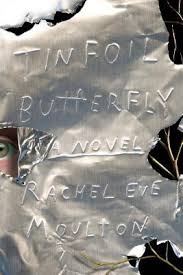Tinfoil Butterfly by Rachel Eve Moulton
 Monday, September 9, 2019 at 8:14AM
Monday, September 9, 2019 at 8:14AM 
Published by Farrar, Straus & Giroux on Sept. 10, 2019
Tinfoil Butterfly is a disturbing novel about a young woman and a child, damaged in different ways, who share a harrowing experience. The story is simple — only four characters play a significant role — but simplicity amplifies the novel’s power.
Emma Powers flees from a hospital and gets a ride with a creep who doesn’t want to let her out of his van. Emma’s goal is to get to the Badlands. The creep has seen newspaper stories about Emma and Raymond, her stepbrother. The creep eventually regrets meeting her.
Emma is messed up. She narrates the story in the first person, eventually explaining why she is messed up and why she and Raymond made it into the newspaper.
Emma meets a kid named Earl after taking the creep’s van and running out of gas at an abandoned diner. Earl is also creepy, an imaginative child who has an unhealthy obsession with death. At the same time, Earl’s talent for creating creatures from tinfoil and seemingly bringing them to life suggests that life and death are struggling for dominance in Earl’s persona. Like Emma, Earl has secrets that the reader eventually discovers, one of which alters the reader’s fundamental understanding of the character.
Earl lives with an older fellow named George, a man whose health appears to be failing. George might be the creepiest of all the characters who enter Emma’s life.
Earl and George live in a deserted house in a ghost town. It’s the kind of house where no sensible person would want to visit the cellar. So, of course, Emma explores the cellar. She doesn’t like what she finds. Events in her life roll downhill from there.
Despite the visit to the cellar, Tinfoil Butterfly isn’t a traditional horror novel, although it is marketed in that genre. The novel’s true horror is not the fear of crazed killers in remote areas (although that fear is part of the story), but the horror of living a tragic life — a broken home, an abusive parent, drug addiction, unhealthy relationships. Ordinary horrors can lead to extraordinary evil, the novel seems to say.
Yet the story is not without hope. Emma is messed up, but she does not have an evil heart. The opportunity to bring some good into another person’s life might be her path to redemption. Rachel Eve Moulton conveys the immediacy of Emma’s conflicting emotions, creating empathy for a broken woman who deserves a second chance.
The story moves quickly and creates genuine anxiety, although the ending is one a reader might predict. Conflicts essential to the plot are resolved, but what will become of Emma after the story ends is unclear. Happy endings, Moulton implies, are too much to expect. The opportunity for a new beginning might be the best anyone with a difficult life can hope to find. What the novel’s surviving characters will make of that opportunity is a story waiting to be told.
RECOMMENDED
Reader Comments